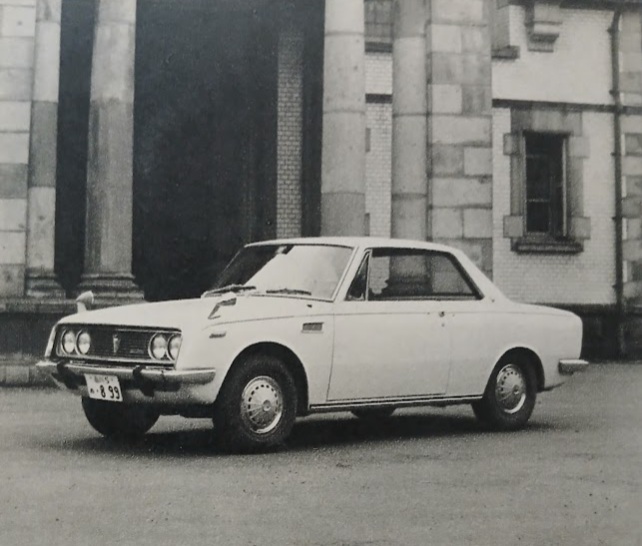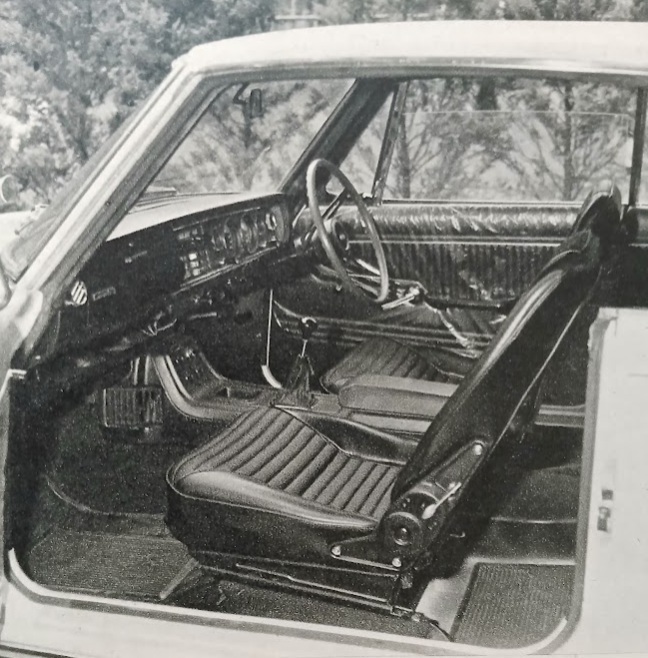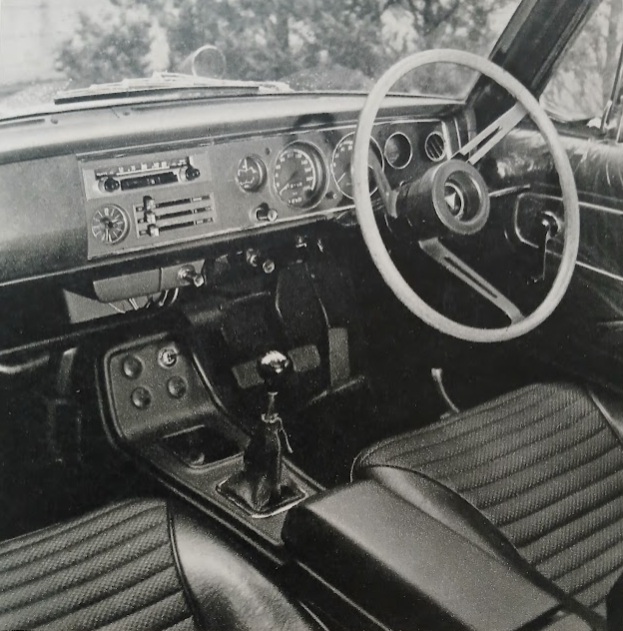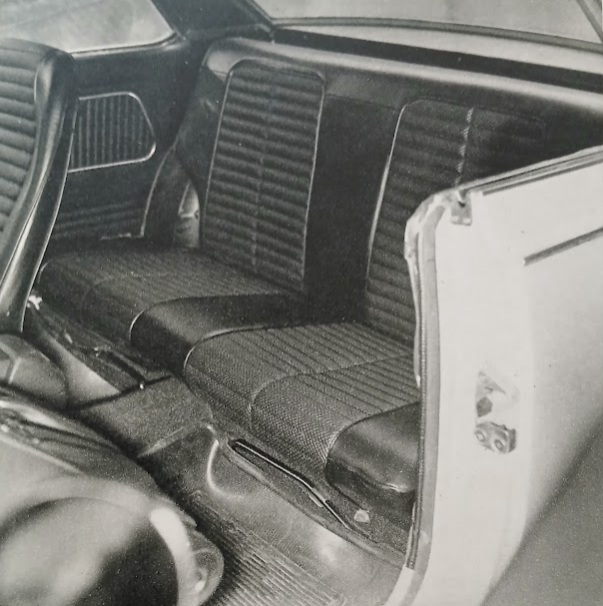Toyota 1600GT (1967)
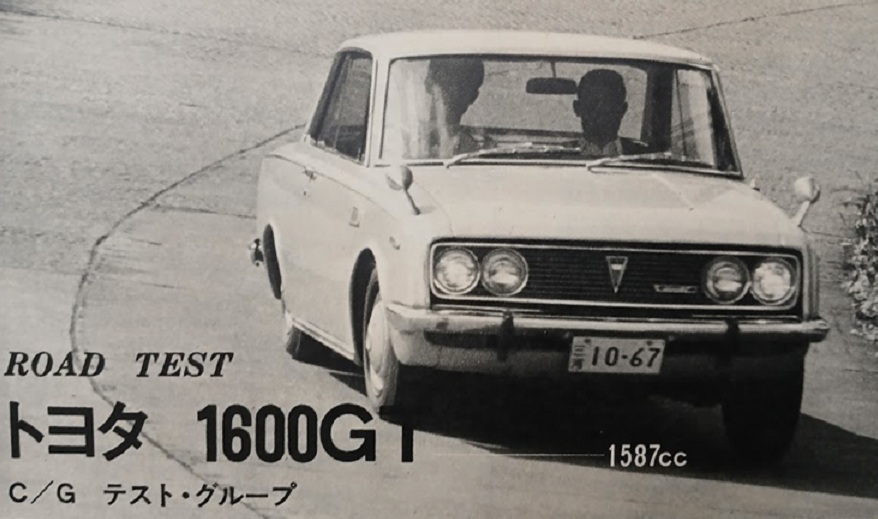
Publication: Car Graphic
Format: Road Test
Date: November 1967
Author: “C/G Test Group” (uncredited)
Road testing the Toyota 1600GT
We tested two Toyota 1600GTs for a total of about 800km, both the GT4 model with the standard 4-speed gearbox, and the GT5 with the optional 5-speed gearbox. The GT5 was a very early production model, while the GT4 was a more recent production model, so there were differences in other details besides the gearbox. We will discuss this later, but our conclusion is that both cars have their pros and cons, but as far as the gearbox is concerned, the GT4 is more suitable for general use in mainly urban areas, while driving enthusiasts should choose the GT5 even if it means some inconvenience.
The 1600GT (internal name RT55, RT55-M for the 5-speed) is, of course, a Corona 1600S hardtop (RT51) equipped with a 110ps DOHC engine and reinforced suspension, so in this report we will avoid overlapping with the 1600S as much as possible and focus solely on the unique features of the 1600GT.
The interior of the 1600GT is, to put it simply, a common man’s version of the 2000GT, with blacked-out everything from the seats to the dash, and a very high standard of design and finish. The front bucket seats are “borrowed” from the 2000GT, and are more generously bolstered than those of the 1600S, providing excellent lateral support even without the aid of the three-point seat belts (which are standard equipment). However, the cushions are extremely thin and lack “give,” and feel very unwelcoming to the driver at first. But judging from the fact that no discomfort is felt even after long drives, this must be an appropriate design. Although the seating position is slightly lower than that of the 1600S, the driving position is natural, and forward visibility over the relatively low cowl is excellent.
There is a padded horn button in the center of the steering wheel, and you have to take your hand off the rim to sound the horn, which is a puzzling feature on this car (the 1600S, with its horn buttons embedded in the spokes, is better in this respect). The dashboard is exactly the same as in the 1600S, except the speedometer and rev counter scales have been extended to 200km/h and 9000rpm, respectively. The instruments are well designed and arranged, with white markings on a black background and red needles that can be read in an instant. One reason for this is that the instruments are relatively far from the seating position, so when you shift your gaze from the road surface to the instruments, your eyes do not have to re-focus. However, for the same reason, the light and wiper switches on the dash are too far away from the reclined driving position that a 1600GT driver will instinctively (or intentionally) assume.
The center console is a unique feature of the 1600GT. The front panel has a switch for the electric radio antenna, and three blank holes for the various accessories that the owner will likely add later. At the rear of the console is a fairly large storage box that doubles as an armrest. The inside of this box is carpeted, so you can put a camera or other items inside. It does not lock, however.
The shift lever protrudes from this console, but the position and angle of the lever differ between the 4-speed and 5-speed gearboxes. The 4-speed’s lever is the same as the 1600S, so it is bent quite sharply backwards, while the 5-speed lever is almost vertical, like the 2000GT. In neutral, the knob is in almost the same position on both, but the movement is completely different. The knob on the 5-speed moves in a horizontal plane through the gates, while on the 4-speed it moves around the shape of a sphere. With the 4-speed, your hand may get caught between the knob and the console box when you quickly shift into second gear.
The pedals are identical to other Coronas. Therefore, the brake and organ-type throttle pedal are so widely spaced that heel-and-toe braking and double-clutch downshifting, essential for driving a sports car like a sports car, are all but impossible.
The rear seats are better than the “+2” type that is common in this type of GT coupe, and although it is of course more cramped than the Corona sedan, there is still enough room for two adults to sit comfortably. However, the front seats can be slid 20mm further back than in the 1600S, and in this position there will not be enough knee room in the rear seats, forcing passengers to sit with their legs at an angle.
It’s nice that there are storage spaces for small items all over the cabin. We’ve already mentioned the console box, but there is also a small, deep compartment in front of it that is extremely useful for storing coins and cigarettes. The glovebox is good-sized, and inside its right corner are a map reading lamp and an inspection light socket. There is a shelf under the glovebox where you can place documents or a handbag, and a total of six flexible pockets–one in each door, on both sides of the rear seats, and on the rear of the front seat backrests–for road maps, newspapers, magazines, etc. Furthermore, behind the rear seats, there is a recess large enough to hold a small suitcase, although it is not as large as that in a Volkswagen. If the rear seats are folded forward and secured with the well-designed metal fittings, the rear compartment is completely covered with carpet and becomes a vast luggage area. If only there was a strap (or at least a metal fitting for one) to secure a suitcase, like in a Porsche, it would be perfect for long-distance, high-speed trips for two people (isn’t that what a Gran Turismo is originally supposed to be?).
In our experience with the two 1600GTs, the DOHC 110ps engine always ran smoothly and was completely trouble-free. When the ignition key was turned on, the electromagnetic fuel pump at the rear started to work with a gentle hum, filling the twin Solex 40PHH carburetors’ float chambers. Cold starts in the morning were always instantaneous if you pulled the choke knob (the trick is not to press the throttle when doing this), and there was no stalling even if we immediately released the choke. The engine warmed up quickly, and in summer temperatures the water temperature gauge needle started to move in about three minutes. The idle of about 700rpm was quite rough even by sports engine standards, and the gear lever vibrated a lot.
In terms of power performance, both in the catalog figures and in our actual measurements, there was no significant difference between the 4-speed and 5-speed gearboxes, but in terms of practical usability, the difference is pronounced. First, for comparison, the gear ratios for the GT4 and GT5, respectively, are as follows: 3.67/3.14 (first), 2.11/1.64 (second), 1.40/1.18 (third), 1.00/1.00 (fourth), and 0.84 (fifth, GT5 only). The standard final drive ratios are also different for the 4-speed and 5-speed, being 4.11 and 4.38, respectively.
Testing was carried out first with the 5-speed gearbox (GT5), and this test car was one of the earliest production models, while the 4-speed was tested later. There were some defects that had already been fixed by the time the second test car (GT4) was built, so we would like to cover the GT5 first. The fully synchronized 5-speed gearbox was “taken” intact from its big brother, the 2000GT, so the gear ratio is by no means ideal for the power characteristics and weight of the 1600GT. To begin with, the first gear ratio is too high for the car’s weight, and also, first and second gears are too far apart (the step-ups between ratios are 0.52 from first to second gear, 0.72 from second to third, 0.84 from third to fourth, and 0.84 from fourth to fifth). As a result, testers who drove the GT5 for the first time almost unanimously complained that acceleration from a standstill was lackluster; to put it bluntly, it was so sluggish that it was as if the car was starting with the handbrake on.
The heavy throttle pedal only adds to this feeling. In truth, this is not just a matter of feeling, and for the first 10 meters or so (which is what matters at traffic lights), the GT5 can’t even keep pace with a briskly-driven Corolla. On the other hand, first gear can extend up to over 50km/h, so you can catch up with and overtake most cars in less than 20 meters. If you don’t wind it up in first gear, though, the momentum will drop drastically as soon as you upshift to second gear, which is relatively even taller, so this is also necessary for self-preservation in traffic.
The clutch of the GT5 we tested required much more force to press (10kg) than the GT4 we drove later, making it unsuitable for frequent use in the city, but it worked reliably with little slip. The near-vertical lever of the 5-speed gearbox is well-placed, and our hands found it naturally when lowered from the steering wheel. It was also good that it had short movements, but it was extremely stiff for a car with a mileage of about 3,400km. As mentioned above, second gear has a tall ratio, and we often needed to downshift into first gear after turning a corner at a walking pace, but it took an almost violent amount of force to shift down to first gear while the car was moving. Also, when we were driving in second gear and came to a stop, the gear lever would often get stuck.
Embarrassingly for us, it is extremely difficult to express the characteristics of the 1600GT engine. Because it is a DOHC, 68ps per liter high-output unit, one might imagine it to be a so-called “peaky” engine (an engine that has a very narrow range of revolutions where strong torque is generated, and therefore a sharp torque curve) that requires frequent gear shifting to run well, but the truth is the exact opposite. The curve is flat like a tractor engine, and it produces strong torque of over 12kgm over a wide range of about 2000 to 5500rpm. When you first get into this car, you will usually want to drive in first and second gears around town, but you will soon realize that you can drive just as easily in higher gears.
In our time with the car, we have adopted the lazy method of driving in second gear up to about 50km/h in the city, then skipping third gear and shifting straight to fourth. With this close-ratio gearbox, there is not much point in shifting gears one by one when the speed limit is a low 60km/h. Moreover, the engine is so flexible that if you can drive in second gear, you can also drive in fourth gear without any difficulty. On the other hand, while fourth gear can run smoothly even at 40km/h (about 1300rpm), the driving force in second gear is not as strong at low speeds as you might imagine, and it is impossible to accelerate after turning a corner at about 15km/h (about 1000rpm). It sounds like a very strange story, but the reason for this is probably because the gap between first and second gear is too wide and the engine torque drops sharply below 1500rpm.
In our opinion, a “peaky” engine is better suited to the characteristics of a sports car, even if it makes it a little harder to use at low speeds. In the 1600GT’s case, even if the car actually produces a large amount of torque, it lacks the climax of a sudden surge of power at a certain rpm, making it feel somewhat lackluster and dull.
The 1600GT is not very impressive in the city, but it comes to life when you get it on the highway. The catalog top speed of 175km/h is only possible on a long, straight stretch like those on the Meishin Expressway, and probably with the help of a downhill slope, but it can reach a speed of 160km/h in both fourth gear and overdrive fifth without difficulty. If you rev it up to 7000rpm, you can reach about 150km/h in third gear, and even in second gear you can reach nearly 110km/h. At 110ps, the power is more than sufficient, and acceleration in third and fourth gear is still quite sharp even after exceeding 100km/h. The 1600GT actually becomes livelier from around 100km/h, where the acceleration of the regular 1600S hardtop reaches a plateau. Because third, fourth, and fifth gears are so close to each other, you can reach not only 100km/h but even 150km/h in any of the top three gears. The luxury of being able to choose from three gears at 150km/h is something you rarely experience, and among practical 1600cc class GTs, there is probably no other car like it in the world. The gear shift feels lighter at high speeds, and the synchronization is also effective. As we have already mentioned, the GT5 can be quite inconvenient in the city, but enthusiasts will almost certainly be willing to overlook this for the enjoyment of its high-speed performance.
The extra gear in the overdrive 5-speed is supposed to provide quiet and economical cruising, but when you upshift from fourth gear into fifth (about 3100rpm) at 100km/h, the maximum speed on Japanese public roads, the transmission emits a high-pitched gear whine and the overall noise level actually increases. This is a pity, since the mechanical noise of the engine is surprisingly low. The exhaust noise increases suddenly above 3500rpm and creates resonances inside the body.
It is true that the GT5 has excellent high-speed performance, but the engine, at least in the car we tested, lacks smoothness in the high revolution range. Around 5500-6000rpm, the four-cylinder’s inherent vibration cycles kick in, and at speeds above 140km/h in third, fourth, or fifth gear, the entire drivetrain begins to vibrate quite badly, and we just didn’t have the nerve to sustain such speeds for long.
As mentioned above, this GT5 was an early-production model, and when we asked the manufacturer about this, they told us they had already taken corrective measures. In the GT4 model that was tested later, this vibration period was pushed out of the normal range of revolutions, and it was confirmed that there were no problems with the balance of the drivetrain at high speeds.
Next, let’s talk about the GT4. Its 4-speed gearbox is exactly the same as that of the 1600S, but the final drive ratio is shorter (4.11 compared to 3.70), and the engine is 20ps more powerful, so the acceleration is overwhelmingly better than that of the 1600S. Compared to the GT5, the first gear ratio is much lower, so acceleration from a standstill is much quicker. The gearshift and clutch of the GT4 are much lighter, so it is more suitable for use in the city than the GT5, and there is no need to worry about being left behind by the 1600S at traffic lights. However, the instrumented test results showed that the GT5 is slightly faster in absolute acceleration. Comparing the acceleration from a standing start, the GT4 covers 0-100m in 7.8 seconds (GT5, 7.4 seconds), 0-200m in 11.9 seconds (GT5, 11.3 seconds), 0-400m in 18.3 seconds (GT5, 18.0 seconds). We were unable to record the GT5’s in-gear acceleration times for a variety of reasons, but the GT4’s results demonstrated the incredible flexibility of the DOHC engine. For example, looking at the overtaking acceleration data in third gear, the acceleration times for each 20km/h increment between 30km/h and 110km/h were all exactly 5.0 seconds. This reflects the engine’s broad torque curve, and at the same time, shows how it is too flat to have a real sports-car feeling. Also, when driving it like a sports car, the wide gap between third and fourth gears was clearly felt.
All things considered, the GT4 is best suited for everyday use around town, while the GT5 is best suited to hot-blooded driving enthusiasts.
The 1600GT’s suspension is basically the same as the 1600S Hardtop’s, except that a torque rod has been added to the rear. Its ride is generally firm and flat, with very little roll for a practical vehicle. One tester described the 1600GT as a scaled-down Shelby Mustang GT350 (both in size and performance), and that is certainly true. The suspension design is extremely simple, with an emphasis on manufacturing productivity, and the idea of using wide tires to compensate for this is also in line with the Shelby (and American so-called sports sedans in general). The 1600GT comes standard with low-profile 6.45S-14-4PR tires (Dunlop Grand Speed on the test car) that is a size wider than the 1600S, and a 6.45H-14-4PR is also available for even higher speeds. Partly due to the effect of the limited-slip differential, the road grip of this tire is excellent even on wet roads. Even during a full-throttle racing start, the car gripped the road firmly with only a few meters of wheelspin. The effect of the torque rod was remarkable, and no rear axle tramp was experienced even during sudden acceleration or deceleration.
The handling is surprisingly good, especially when you remember that it is basically the same suspension as the Corona. The steering, with 3.75 turns from lock to lock, is the same as the Corona, so it keeps the driver’s hands a little busy in tight corners, and there is about 5cm of free play at the steering wheel rim when going straight, but once you get used to having to turn the steering wheel that little bit extra when entering corners, it responds surprisingly well. It can even be called precise, and the steering is exceptionally light except when parking.
In order to compensate for the front-heavy weight distribution of 54%/46%, even with two people on board, the tire pressure is specified at 1.9kg/1.7kg (for up to 175km/h), but even so the handling is biased quite heavily towards understeer. Since the body roll is not felt much, at least by the driver, it is easy to enter a corner at speeds too high for the car’s actual capabilities (not to mention the driver’s). The 1600GT seems to reach its cornering limits at speeds more than 30% higher than the 1600S, but once it does, all four wheels tend to let go at once.
We have not yet been able to come to a conclusion on the 1600GT’s brakes. The GT5 test car had very strong stopping power, requiring only light pedal pressure from low speeds up to high speeds of over 150km/h, and its posture in hard stops was stable, so we all agreed that they were among the best brakes we had ever experienced. However, our confidence was greatly shaken by the GT4 we tested later. The braking power itself felt just as strong in the GT4, and as an example, the time from 0 to 100km/h to a complete stop was just 16.9 seconds. However, if we did this two or three times in a row, the brakes immediately faded, the stopping distances increased, the pedal force became heavier, and it took several minutes of rest for the brakes to return to their previous state. We tried going up and down a mountain road with a series of gentle corners at 70 to 90km/h, repeatedly braking hard, and here too we experienced fade. On the way downhill, the left rear wheel locked up and made the car unstable, even though the rear wheel circuit has a proportioning control valve. We suspect that the GT4 and GT5 test cars used different brake pad materials.
Finally, regarding fuel economy, accurate measurements could only be taken for the GT5, but the average fuel economy over 282km of driving in Tokyo and on the Third Keihin National Highway was 6.4km/l. The GT4’s carburetor setting seemed to be overly rich, and a rough measurement suggested its fuel consumption was about 5km/l.
Postscript: Story Photos
